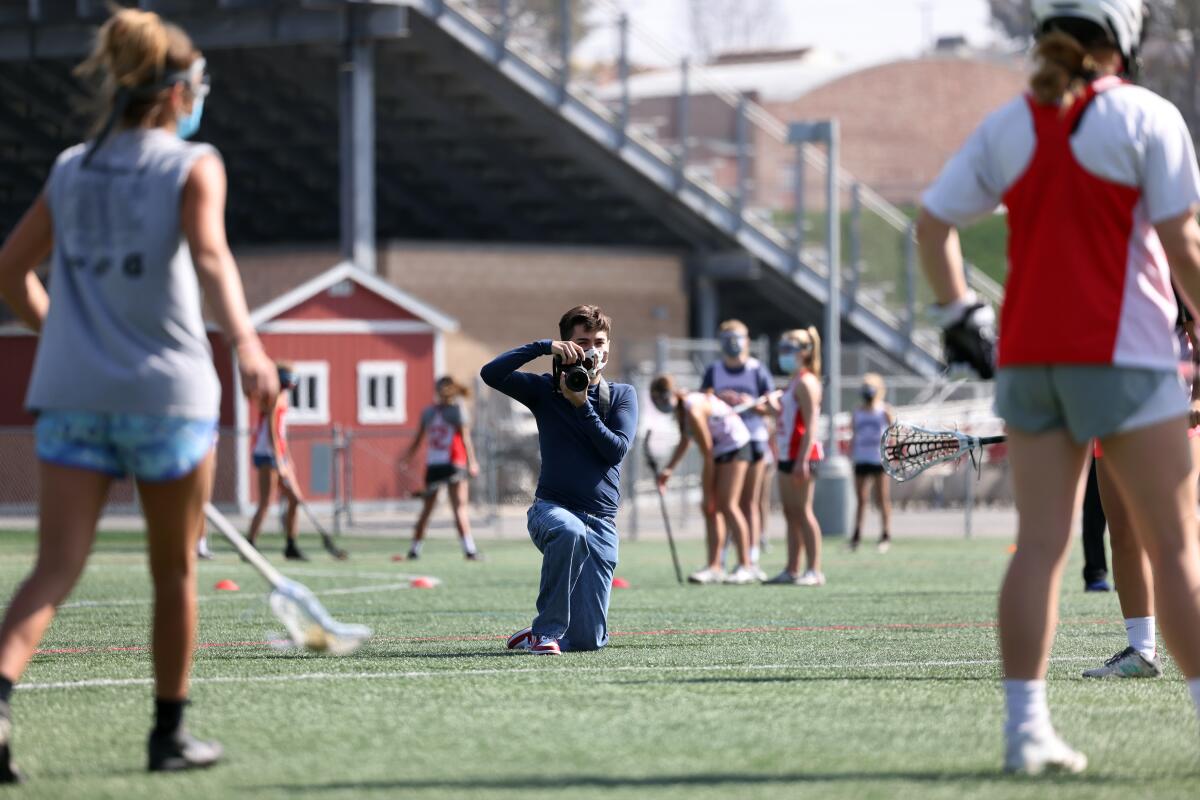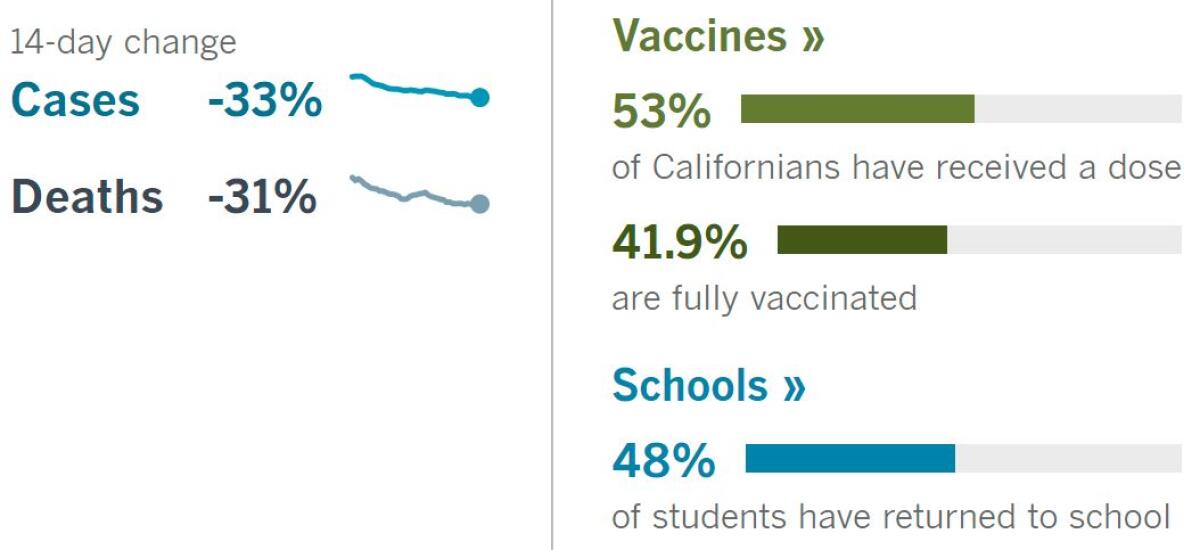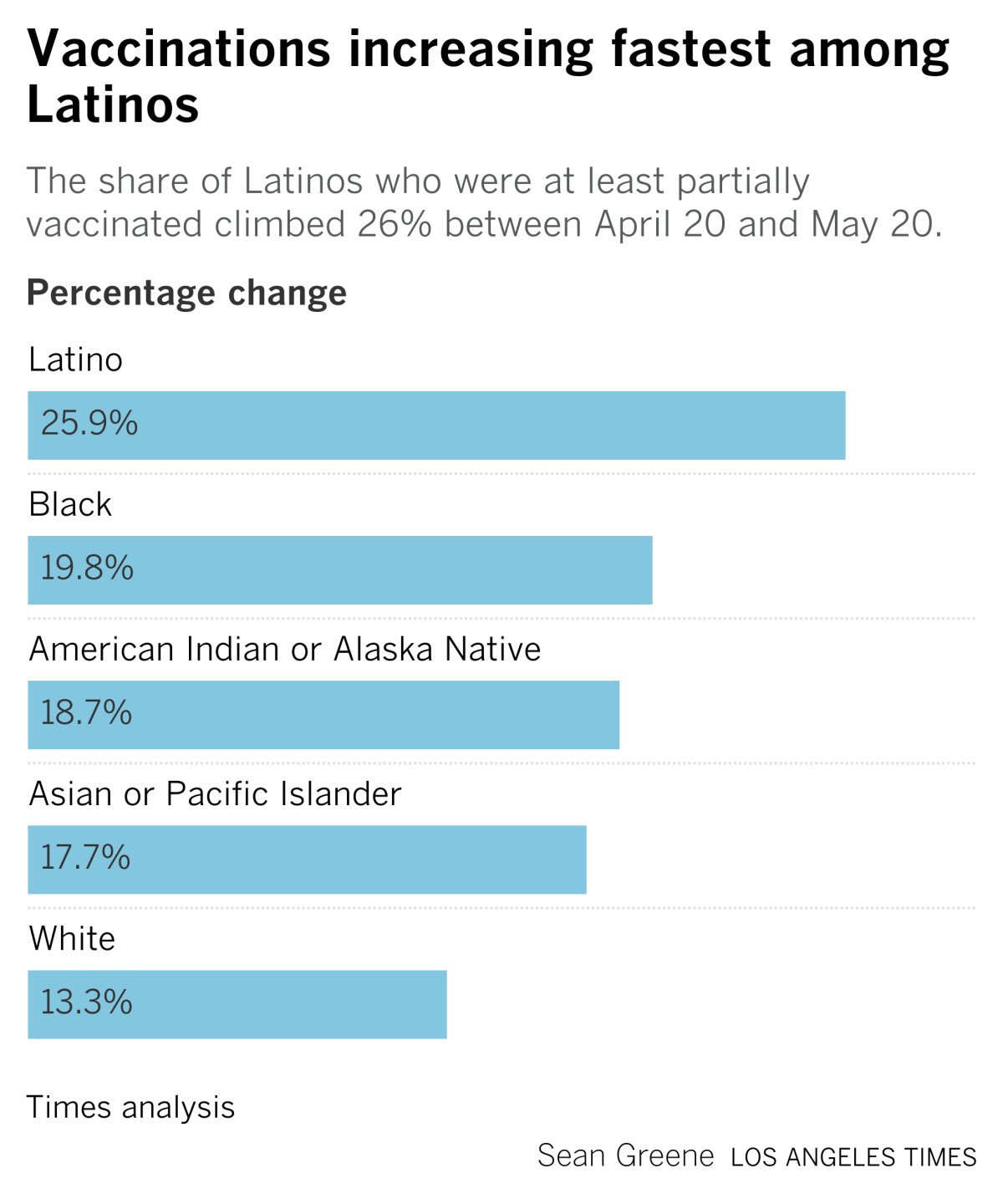Coronavirus Today: How do you capture the pandemic in a high school yearbook?
- Share via
Good evening. I’m Karen Kaplan, and it’s Monday, May 24. I usually edit this newsletter, but today I get a turn to write it instead.
We devote a lot of time and energy to bringing you this daily dispatch, and the kind words of appreciation you’ve been sending us have made it all worthwhile. We’re in the final weeks before the California economy reopens, so let’s jump in and see what’s happening with the coronavirus in California and beyond.
My daughter picked up her high school yearbook on Saturday. The cover features a giant wave reminiscent of this Japanese masterpiece, capturing the moment just before the water crashes to shore and everything changes in an instant. It’s a perfect metaphor for pandemic life.
A yearbook is always a time capsule of sorts, memorializing favorite songs, after-school jobs and hair styles. But this 2020-21 edition is a ready-made piece of history. The senior superlatives includes a category for “Best to be quarantined with.” There are two pages devoted to face mask fashion, and another describing how students handled the sudden disappearance of the SAT.
No yearbook ever comes together easily, but this year’s editions presented a unique challenge to the student editors who pulled them all together. My colleague Laura Newberry takes us behind the scenes to show us what it was like.
Suji Kim, yearbook editor at Redondo Union High School, had to win over classmates who figured the yearbook would be depressingly thin and a physical reminder of all that they had missed: no prom, no football games, no grad night — just day after day of Zoom and sweatpants.
“I tried to reassure them that we are working our hardest to really capture the year for what it is,” Kim said, “that it is something we should commemorate and celebrate and not just shove to the back of our minds.”
Without a campus full of students to photograph, her staff solicited photos from classmates and their parents. The crowd-sourcing effort turned up photos of teens on skateboards and mountain bikes, walking their dogs, baking bread. Student photographers coached their peers on how to take a selfie worthy of a yearbook portrait, using Zoom to offer tips on how to angle their bodies and capture the light with their phones.
In mid-February, when student athletes were finally allowed back on campus for workouts, yearbook photographers who had been starved of opportunities for action shots documented the practices as if they were conference finals. By early April, they were scrambling to cover the equivalent of three compressed sports seasons in the span of just eight weeks.

The ubiquity of Zoom was an unavoidable topic, but “we don’t want to have Zoom screenshots for every single spread,” Meena Kabbani, one of Kim’s fellow editors, explained.
To branch out, there were pages devoted to students’ response to the national reckoning on race, including some who participated in Black Lives Matter marches and others who spoke up about police brutality on social media.
There was a spread about how students’ relationships with friends, parents and others morphed and grew while they spent so much time at home.
There was even a section about how spending so much time alone caused some students to dig deeper into their personal identities, prompting some to recognize shifts in their political views and others to come out as queer and transgender.
For Kim, who will be a freshman at the University of Pennsylvania in the fall, the end result is a triumph.
“I might not have had a prom or senior ditch day,” she said, “but at least I have this yearbook.”
By the numbers
California cases, deaths and vaccinations as of 6:05 p.m. Monday:

Track California’s coronavirus spread and vaccination efforts — including the latest numbers and how they break down — with our graphics.

Across California
Next year’s yearbooks should be a lot more typical, at least in Los Angeles. L.A. Unified School District campuses will reopen on a normal, full-time schedule in the fall, Supt. Austin Beutner announced Monday.
“Looking down the path to recovery and the new school year which starts this fall, all students will have the opportunity to participate in full-day, on-campus, in-person instruction,” Beutner said in a recorded broadcast. “That means elementary school students will be on campus five days a week for a full day of in-person instruction with their teacher and classmates. Middle school and high school students will be on campus five days a week for a full schedule of instruction, changing classrooms for each period.”
Beutner’s broadcast came a day after about 70 parents had gathered outside LAUSD headquarters to demand a full reopening and then marched about 2.5 miles west to the headquarters of the United Teachers Los Angeles union.
In interviews, the parents accused the teachers union of not prioritizing the on-campus education and the school district of not standing up to union demands, my colleagues Howard Blume and Colleen Shalby report.
Among other things, they were angry that the district delayed the reopening of campuses until teachers and other school employees had the opportunity to become fully vaccinated — something health officials did not require.
Like all school systems in California, LAUSD will soon need to abide by the state resumption of rules that largely link funding to in-person school attendance in the new academic year. Emergency pandemic rules that have allowed districts to operate online are set to expire on June 30.
UTLA President Cecily Myart-Cruz did not say the union would oppose a resumption of a full-time schedule. But she made it clear that the union intends to negotiate intensely for working and learning conditions that she said would be in the best interests of educators and families.
Beutner also pressed ahead on the COVID-19 immunization front Monday, with the official launch of LAUSD’s school-based campaign to vaccinate middle and high school students. Campuses that reach a 30% vaccination threshold will win $5,000 to spend as they choose, he announced. Beutner said he’s especially concerned about lagging adult and student vaccine rates in lower-income communities.
Latino and Black Californians are now getting COVID-19 shots at a relatively faster rate than members of other racial and ethnic groups, according to a Times analysis of state data.

There’s still a significant overall disparity in the percentage of Latino and Black Californians who are at least partially vaccinated. Only about 35% of Latino and 36% of Black residents are at least partially vaccinated, while 52% of white, 49% of Native American and 63% of Asian American residents are at least partially vaccinated, the data show.
But over the last month, the percentage of Latinos who were at least partially vaccinated climbed from 28% to 35% — accounting for a relative percentage jump of 26%, the fastest among all racial and ethnic groups. The percentage of Black residents who received at least one dose rose from 30% to 36% over the same time period, up 20%.
The statewide trends mirror the trends in Los Angeles County, but it’s “not enough to close the gaps,” said L.A. County Public Health Director Barbara Ferrer.
“Over these next few weeks, as we prepare for our full reopening, we do need to double down on our efforts to reduce any barriers to vaccination in hard-hit communities,” she said.
The county is making progress: Half of L.A. County residents 16 and older are now fully vaccinated against COVID-19, and the county is racing to immunize millions more before the statewide reopening come June 15.
In particular, there’s still plenty of room for improvement among younger Angelenos, who have been eligible for vaccination only since last month. As of Friday, 46% of county residents 16 to 64 had been fully vaccinated, including only 28% of those who are either 16 or 17, according to county data.

See the latest on California’s coronavirus closures and reopenings, and the metrics that inform them, with our tracker.
Consider subscribing to the Los Angeles Times
Your support helps us deliver the news that matters most. Become a subscriber.
Around the nation and the world
If any doubt remains that the COVID-19 pandemic is a truly global affair, consider this: Mt. Everest is in the midst of an outbreak that has infected at least 100 people.
So says Lukas Furtenbach, an expert climbing guide from Austria who halted an Everest expedition last week due to virus fears.
Furtenbach said one of his foreign guides and six Nepali Sherpa guides have tested positive for the coronavirus. And they’re not the only ones, he said — the base camp staging area is home to many people who are visibly sick and can be heard coughing in their tents.
“I think with all the confirmed cases we know now — confirmed from [rescue] pilots, from insurance, from doctors, from expedition leaders — I have the positive tests so we can prove this,” Furtenbach said over the weekend.
A climber from Norway tested positive for a coronavirus infection two months ago, becoming the first confirmed case at the base camp. But mountaineering officials in Nepal have denied there were any active cases there or at any of the country’s other base camps. Mountaineering was closed last year due to the pandemic.
Next door in India, doctors have noticed a disturbing rise in cases of a life-threatening fungal infection affecting people with COVID-19 or those who have recovered from the disease.
The infection is called mucormycosis. It’s caused by exposure to mucor mold, which commonly found in soil, air and even in the nose and mucus of people. The infection can spread through the respiratory tract and to vital organs; sometimes surgeons have had to remove a patient’s eye to prevent the infection from reaching the brain.
It is relatively rare, and it was present in India before the pandemic. But it preys on patients with weakened immune systems, which could explain the sudden increase in cases. Federal minister Sadananda Gowda said nearly 9,000 cases had been reported in India so far, leading to a shortage of Amphotericin B, the drug used to treat the condition.
“It is a new challenge, and things are looking bleak,” said Ambrish Mithal, the chairman and head of the endocrinology and diabetes department at Max Healthcare, a chain of private hospitals in India. “Earlier, I used to come across just a few cases every year,” he added, “but the current infection rate is frightening.”
The number of deaths threatens to complicate India’s fight against the pandemic further. On Monday, the country’s death toll passed the 300,000 mark. Only the United States and Brazil have recorded more COVID-19 deaths.
And in Iran, efforts to fight a new surge are hampered by an exodus of healthcare workers, my colleague Omid Khazani reports.
U.S. sanctions, supply-strapped hospitals and the country’s nosediving economy are prompting medical professionals there to seek better opportunities elsewhere. Senior Iranian officials say an additional 53,000 nurses and doctors are needed to fight the outbreak there, yet about 3,000 doctors left the country last year, according to the Medical Council of Iran.
Reaction to that latter figure ranged from sympathy for those who left and criticism of the government’s lack of support for doctors to blame on rich countries for stealing human capital from developing countries as the pandemic unfolded. Hundreds of people are dying of COVID-19 every day in Iran, and hospitals are overwhelmed with COVID-19 patients.
Doctors began joining Iran’s long-running brain drain in earnest during the hardline 2005-13 presidency of Mahmoud Ahmadinejad. Specialists had more incentive to stay put because many were reaping the benefits of a booming medical tourism industry. But the pandemic has now largely choked off that source of income.
“I wish I had the chance to retire to my hometown, but with job security and a good income gone, it’s a dream now,” said Dr. Omid Tonekaboni, an emergency specialist with more than two decades of experience under his belt who now hopes to move to Germany. “I don’t think that emotional bonds can keep me here any longer.”
Your questions answered
Today’s question comes from readers who want to know: Can the COVID-19 vaccine affect my hearing?
No. Although there have been scattered reports of people experiencing sudden hearing loss after getting a dose of the COVID-19 vaccine, researchers say the two are not related.
Nearly 287 million doses of COVID-19 vaccine have been injected into arms in the U.S., according to the latest figures from the Centers for Disease Control and Prevention. When you give out that many shots, you’re bound to hear of all kinds of things happening to people in the days afterward. The trick is figuring out whether they’re side effects caused by the vaccine, or if the timing was merely a coincidence.
In the case of hearing loss, the evidence points toward a coincidence. That’s the finding of a study published last week in the journal JAMA Otolaryngology-Head and Neck Surgery.
Doctors from Johns Hopkins University treated some of the people who suffered from sudden hearing loss within a day of getting a COVID-19 shot. They got curious about the connection and dug into the data.
They scoured a government database used for reporting potential vaccine side effects and turned up 147 possible cases of sudden hearing loss, 40 of which seemed particularly credible (based on documentation from a doctor) and plausible (considering the time lag between the shot and the onset of hearing loss). Based on the number of doses administered, they determined that the incidence of sudden hearing loss after getting a COVID-19 vaccine was somewhere between 0.3 and 4.1 cases per 100,000 people.
Even the high end of that range was far below the incidence of such hearing loss in pre-COVID times. In general, it’s not clear how often sudden hearing loss occurred prior to the pandemic, since many patients mistakenly think their condition is a temporary problem due to something like allergies or a sinus infection — but published reports have put it somewhere between 11 and 77 cases per 100,000 people, depending on a patient’s age.
Despite the uncertainty, one thing is clear: “No association exists” between the vaccines and sudden hearing loss, the doctors concluded.
We want to hear from you. Email us your coronavirus questions, and we’ll do our best to answer them. Wondering if your question’s already been answered? Check out our archive here.
Resources
Need a vaccine? Sign up for email updates, and make an appointment where you live: City of Los Angeles | Los Angeles County | Kern County | Orange County | Riverside County | San Bernardino County | San Diego County | San Luis Obispo County | Santa Barbara County | Ventura County
Need more vaccine help? Talk to your healthcare provider. Call the state’s COVID-19 hotline at (833) 422-4255. And consult our county-by-county guides to getting vaccinated.
Practice social distancing using these tips, and wear a mask or two.
Watch for symptoms such as fever, cough, shortness of breath, chills, shaking with chills, muscle pain, headache, sore throat and loss of taste or smell. Here’s what to look for and when.
Need to get tested? Here’s where you can in L.A. County and around California.
Americans are hurting in many ways. We have advice for helping kids cope, resources for people experiencing domestic abuse and a newsletter to help you make ends meet.
We’ve answered hundreds of readers’ questions. Explore them in our archive here.
For our most up-to-date coverage, visit our homepage and our Health section, get our breaking news alerts, and follow us on Twitter and Instagram.




